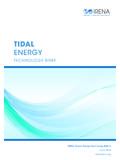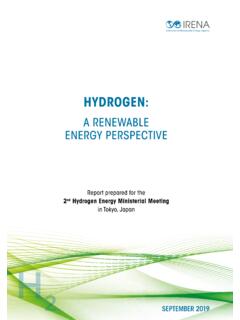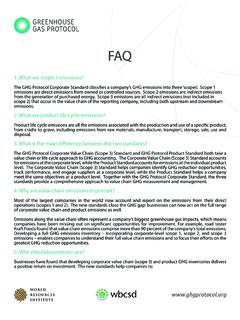Transcription of GLOBAL ENERGY TRANSFORMATION
1 GLOBAL ENERGY . TRANSFORMATION . IRENA 2018. Unless otherwise stated, material in this publication may be freely used, shared, copied, repro- duced, printed and/or stored, provided that appropriate acknowledgement is given of IRENA. as the source and copyright holder. Material in this publication that is attributed to third parties may be subject to separate terms of use and restrictions, and appropriate permissions from these third parties may need to be secured before any use of such material. ISBN 978-92-9260-059-4. About IRENA. The International Renewable ENERGY Agency (IRENA) is an intergovernmental organisation that supports countries in their transition to a sustainable ENERGY future, and serves as the principal platform for international co-operation, a centre of excellence, and a repository of policy, technology, resource and financial knowledge on renewable ENERGY .
2 IRENA pro- motes the widespread adoption and sustainable use of all forms of renewable ENERGY , including bioenergy, geothermal, hydropower, ocean, solar and wind ENERGY in the pursuit of sustainable development, ENERGY access, ENERGY security and low-carbon economic growth and prosperity. Acknowledgements Valuable external review was provided by Martha Ekkert & Martin Sch pe (BMWi), Morgan Bazilian (Colorado School of Mines), Kim M ller Porst (EFKM), Luiz Barroso & Rafael de S Ferreira (EPE), Wang Zhongying (ERI), Andreas Kraemer (IASS), Laura Cozzi, Paolo Frankl, Timur Gul & Andrew Prag (IEA), Doug Arent & Jeff Logan (NREL), Mauricio Tolmasquim (PPE), and Ben King & Paul Spitsen (US DOE). The authors would like to extend a special thanks to Deger Saygin (SHURA ENERGY Transition Centre).
3 Valuable review and feedback was provided by IRENA colleagues Ahmed Abdel-Latif, Yong Chen, Bowen Hong, Paul Komor, Divyam Nagpal, Thomas Nikolakakis, Asami Miketa, Elizabeth Press, Hameed Safiullah, Emanuele Talbi, Michael Taylor, and Henning Wuester. The editor of this report was Robert Archer. Consultants for REmap who assisted in preparation of this report include Toby Couture, David Jacobs and Owen Zinaman. The macro-economic modelling (E3ME) results were provided by Hector Pollitt, Jon Stenning, Eva Alexandri, Stijn Van Hummelen, Unnada Chewpreecha, and other team members of Cambridge Econometrics, UK. Contributing authors: This report was prepared by the REmap team at IRENA's Innovation and Technology Centre (IITC). and Policy Team at IRENA's Knowledge, Policy and Finance Centre (KPFC).
4 The REmap analysis and sections were authored by Dolf Gielen, Ricardo Gorini, Nicholas Wagner, Rodrigo Leme, Laura Gutierrez & Gayathri Prakash, with additional contributions and support by Paul Durrant, Luis Janeiro & Jennifer Winter. The socio-economic analysis and sections were authored by Xavier Casals, Bishal Parajuli, Michael Renner, Sandra Lozo, Arslan Khalid, lvaro L pez-Pe a and Rabia Ferroukhi. IRENA is grateful for the generous support of the Federal Ministry for Economic Affairs and ENERGY of Germany, which made the publication of this report a reality. Report citation IRENA (2018), GLOBAL ENERGY TRANSFORMATION : A roadmap to 2050, International Renewable ENERGY Agency, Abu Dhabi. This report is available for download from For further information or to provide feedback, please contact IRENA at Disclaimer This publication and the material herein are provided as is.
5 All reasonable precautions have been taken by IRENA to verify the reliability of the material in this publication. However, neither IRENA nor any of its officials, agents, data or other third-party content providers provides a warranty of any kind, either expressed or implied, and they accept no responsi- bility or liability for any consequence of use of the publication or material herein. The information contained herein does not necessarily represent the views of the Members of IRENA. The mention of specific companies or certain projects or products does not imply that they are endorsed or recommended by IRENA. in preference to others of a similar nature that are not mentioned. The designations employed and the presentation of material herein do not imply the expression of any opinion on the part of IRENA concerning the legal status of any region, country, territory, city or area or of its authorities, or concerning the delimitation of frontiers or boundaries.
6 2. F O R E WO R D. Foreword In an era of accelerating change, the imperative to limit climate change and achieve sustainable growth is strengthening the momentum of the GLOBAL ENERGY TRANSFORMATION . The rapid decline in renewable ENERGY costs, improving ENERGY efficiency, widespread electrification, increasingly smart technologies, continual technological breakthroughs and well-informed policy making all drive this shift, bringing a sustainable ENERGY future within reach. While the TRANSFORMATION is gaining momentum, it must happen faster. Around two-thirds of GLOBAL greenhouse gas emissions stem from ENERGY production and use, which are at the core of efforts to combat climate change. To meet climate goals, progress in the power sector needs to accelerate further, while the decarbonisation of transport and heating must pick up steam.
7 As this report makes clear, current and planned policies offer a comparatively slow path, whereby the world would exhaust its ENERGY -related carbon budget in under 20 years, in terms of efforts to keep the GLOBAL temperate rise well below 2 C. The budget for a C limit, meanwhile, would potentially run out in less than a decade. Adnan Z. Amin The ENERGY system, consequently, requires rapid, immediate and sustained change. The Director-General, IRENA. deployment of renewables must increase at least six-fold compared to the levels set out in current plans. The share of electricity in total ENERGY use must double, with substantial electrification of transport and heat. Renewables would then make up two-thirds of ENERGY consumption and 85% of power generation. Together with ENERGY efficiency, this could deliver over 90% of the climate mitigation needed to maintain a 2 C limit.
8 Fortunately, this is also the path of opportunity. It would enable faster growth, create more jobs, create cleaner cities and improve overall welfare. In economic terms, reducing human health and environmental costs would bring annual savings by 2050 up to five times the additional annual cost of the transition. The GLOBAL economy in 2050 would be larger, with nearly 40 million jobs directly related to renewables and efficiency. Timely action would also avoid stranding over USD 11 trillion worth of ENERGY -infrastructure assets that are tied to today's polluting ENERGY technologies. Along with analysing options, this report examines the socio-economic footprint of the shift to renewables, providing insights into how to optimise the outcome. Policies to promote a just and fair transition can maximise the benefits for different countries, regions and communities.
9 Transforming the GLOBAL ENERGY system would permit affordable, and universal, ENERGY access, increase ENERGY security, and diversify ENERGY supply. The world's actions today will be crucial to create a sustainable ENERGY system. Ultimately, the path to secure a better future depends on pursuing a positive, inclusive, economically, socially and environmentally beneficial ENERGY TRANSFORMATION . A Renewable ENERGY Roadmap 3. 4. CO NTE NT S. Executive Summary .. 08. Introduction.. 16. Status of the ENERGY transition: A mixed picture.. 18. ENERGY -related carbon dioxide emissions: Bridging the gap .. 21. A pathway for the TRANSFORMATION of the GLOBAL ENERGY system.. 23. Country ambition for the ENERGY transition.. 28. Analysis and insights in key sectors.. 31. Transport .. 31. Buildings.
10 33. Industry .. 36. Power .. 38. Costs, investments and reduced externalities of the ENERGY transition .. 41. Socio-economic benefits of the ENERGY transition.. 44. GLOBAL GDP.. 47. Employment in the GLOBAL economy.. 49. GLOBAL ENERGY sector employment .. 51. GLOBAL welfare.. 54. Regional GDP, employment, welfare.. 57. How finance affects the ENERGY transition.. 62. Key socio-economic messages .. 65. How to foster the GLOBAL ENERGY TRANSFORMATION : Key focus areas.. 68. Focus Area 1. Tap into the strong synergies between ENERGY efficiency and renewable .. 69. Focus Area 2. Plan a power sector for which renewables provide a high share of the ENERGY .. 70. Focus Area 3. Increase use of electricity in transport, building and industry.. 70. Focus Area 4. Foster system-wide .. 71. Focus Area 5.












